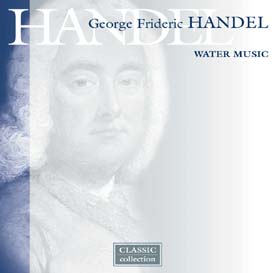This recording was originally issued on Collins Classics
in 1990 and when it was first issued it was reviewed in The Gramophone
as 'the best middle-of-the-road recording of this music to date'. Despite
their name, the Consort of London play on modern instruments. But some
musicological thought has obviously gone into these performances. The
three suites (confusingly labelled 1, 2 and 3) are played in the most
sensible order with the quieter Suite in G in the middle. We know surprisingly
little about the first performance of these works, so it is sensible
to order them in a way that works musically. The Suite in F is concluded
with two movements from the Suite in D which Handel re-arranged into
F major. As these are the only two movements that we possess in Handel's
manuscript, it is good that we can hear them and they make a fitting
conclusion to the otherwise rather open ended Suite in F.
Care has also been taken with the sound of the group.
You only have to listen to the opening to chords of the Overture to
the Suite in F to realise this. Crisply played, double dotted with plenty
of air between the notes. This is stylish playing, well aware of the
fine stylistic line that must be trodden if you want to bring off a
performance on modern instruments that is period aware. No attempt is
made to try and recreate the original performances, so we have no improvised
drum part (the presence of trumpets would imply that drums might have
been used). The performance here includes a harpsichord. No mention
is made of a harpsichord in the original performances (harpsichords
probably do not mix very well with rather damp barges), but by the 1720s
performances of the Water Music were including a harpsichord. Where
the performers here fall down is in the actual sound of the harpsichord.
The instrument used is either not beefy enough for the modern instruments
or its sound was deliberately recessed on the recording. Either way,
what we have is a rather distressing tinkly sound that only really functions
as a continuo in the quieter movements. In fact, it has been suggested
that the quieter, G major Suite would have been played on dry land whilst
the King was at supper and in this case, could quite easily have included
a harpsichord.
The graceful oboist embellishes the solo line in the
Andante and Staccato movement, but generally there is little ornamentation,
which is a shame. The performance gives full value to all of Handel's
repeats, so it would have been rather nice if they had had the courage
to vary them as well. The string and wind playing is admirably crisp
and well articulated. The orchestra has a suitably lean tone which suits
the music well. The strings generally play the notes in a stylised,
detached, marcato manner which is eminently suitable for trying to make
this music work on modern instruments. From the very opening the band
sounds stylish and very period aware, with minimum vibrato from the
strings. Marriner's Academy of St. Martin's in the Fields make a far
lusher string sound. You only have to compare the opening movements
to hear a radical difference. Not only is Marriner far slower, but his
performance is much more romantic. Haydon Clark's tempos are generally
on the steady side, particularly when compared to Charles Mackerras
and the Orchestra of St. Luke’s on Telarc. Mackerras often favours quite
brisk tempos. Too often Haydon Clark's Consort of London sound as if
they are plodding steadily rather than shaping the music. Their stylised
delivery can get a little wearing at a steady tempo. The band seem to
be at their best in the more lively movements.
But the difference between the Orchestra of St. Luke’s
and the Consort of London is more than just one of tempo. Mackerras's
group turn in performances which are stylish and crisp but have a shapeliness
and lilt that are missing from the Consort of London. To my ear, this
was particularly true of the bass lines where the Consort of London
do rather plod. But the Orchestra of St. Luke's do not get everything
their own way and when it comes to balance, the Consort of London deliver
a distinctly preferable woodwind-led sound, as compared to the Orchestra
of St. Luke’s rather string dominated sound.
If you are thinking of buying a Water Music on modern
instruments then I would advise trying to listen to Mackerras and the
Orchestra of St. Luke’s as well as this one. But the differences between
the two recordings are, to a certain extent, ones of taste so you may
disagree with me. Either way, if you buy this CD you won't go too wrong
and it represents excellent value. Be warned though, the track numbering
is a little eccentric and there is no booklet at all. Do the publishers
think that with a work as well known as this one we should not need
one?
Robert Hugill
